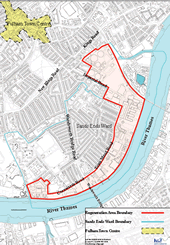H&F "Scaremongering" over Super Sewer Threat to Hammersmith Bridge
Thames Water asks for evidence supporting council's claims
Thames Water is accusing Hammersmith and Fulham Council of "scaremongering" after claims by the council that the Thames Tunnel or super sewer, poses a threat to Hammersmith Bridge.
The council is claiming that work on the project could force the bridge to close for up to a year.
The council says Thames Water wants to drill part of the tunnel almost directly beneath the foundations of Hammersmith Bridge - which the Victorians built in 1827. It goes on to claim that Hammersmith & Fulham Council engineers have voiced concerns that the bridge could be permanently damaged if the ground is "‘destabilised" by the excavation works yards away.
It goes on to "warn" that if the ground settles due to Thames Water’s works, the foundations of the Grade II listed bridge could be undermined, wreaking havoc if the crossing is forced to shut.
However, the council has not named any of the engineeers or provided any direct comments from them, and Thames Water has responded by accusing the council of "scaremongering" and asking to see further evidence.
A spokesman said: " While at first sight this looks very much like the latest in a long line of scaremongering by the council, if they have any supporting evidence to support this claim we will of course look at it very carefully."
Hammersmith and Fulham Council, which has fought a sustained campaign against the Thames Tunnel project is also claiming that dozens of the capital’s other riverside landmarks could also be threatened by Thames Water’s 20 mile long sewer, including The Houses of Parliament, The Tower of London, The Globe Theatre, The London Eye as well Tower Bridge and numerous other river crossings.
Last month, the council responded with fury to a letter from Thames Water outlining its plans to acquire some areas of local property from the council to in the development of the Thames Tunnel.
You can read the full details of that story here.
Throughout its long campaign against the super sewer, the council has claimed there are cheaper, greener and less disruptive alternatives.
However, this campaign is at odds with the government's plans for the tunnel. In July the Department for Communities and Local Government announced that plans for the Thames Tunnel were being referred to the Planning Inspectorate’s National Infrastructure Directorate.
This organisation decides planning applications of "national importance" in England and Wales.
The Department for Communities and Local Government said in spring this year that it regards the proposed tunnel to be a "nationally significant infrastructure project" when it issued a safeguarding direction to Hammersmith and Fulham Council over the site on Fulham's riverside which Thames Water has chosen as its preferred site for building an access shaft to the tunnel.
The direction prevents the council from granting permission for other projects on the site.
Despite the direction, the owners of the site on Carnwath Road - who include the council itself - submitted plans in summer to construct 474 new homes on the riverside site, in buildings up to 12 storeys high.
You can read this story in full here
September 19, 2012
